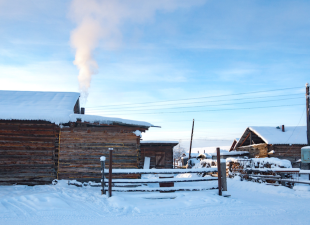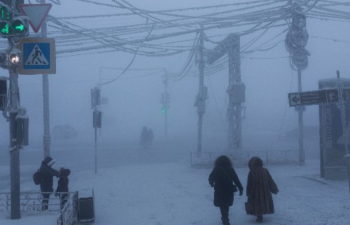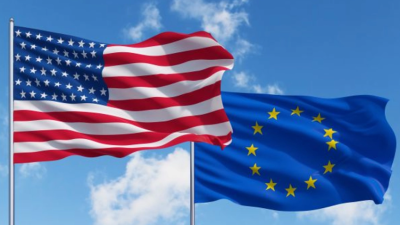There's a place on Earth where temperatures can drop as low as -70°C (-114°F) at their coldest! It's Oymyakon, a small village in eastern Russia.
The people there face a frozen world every day, yet they use their courage and ingenuity to forge a unique way of life.
Oymyakon (Russian: Оймякон) is located in the Sakha Republic in eastern Siberia, 800 kilometers east of its capital, Yakutsk. It covers an area of 422 square kilometers and lies on the upper reaches of the Indigirka River, one of the "cold poles" of the Northern Hemisphere.
Oymyakon is one of the coldest permanently inhabited places in the world, with 500 villagers living there year-round.
Location:
Oymyakon (Russian: Оймякон) is a basin in northeastern Siberia, Russia, at an altitude of approximately 741 meters. It lies 350 kilometers south of the Arctic Circle and is under the jurisdiction of the Sakha Republic of Russia. Oymyakon is located in the center of the eponymous basin on the upper reaches of the Indigirka River in Siberia. Its east, south, and west sides are elevated, with only the north facing side offering lower elevations. This results in an extremely cold climate, earning it, along with Verkhoyansk, the title of "Cold Pole" of the Northern Hemisphere.
On February 6, 1933, the lowest temperature ever recorded in the Oymyakon region of Siberia was -71.2°C, earning Oymyakon the title of "Cold Pole" of the Northern Hemisphere.
Oymyakon's name comes from the Yakut language, meaning "unfrozen water," referring to a hot spring near the village. Reindeer herders often stopped here to let their reindeer drink, leading to its gradual development into a village in the 1920s and 1930s.
Climatic Characteristics
- Characteristics
Oymyakon, located in Eastern Siberia, has a distinct continental climate, characterized by significant annual and diurnal temperature fluctuations. Winters are long and harsh, with the average temperature in January, the coldest month, approaching -50°C. Summers are short and cool, with an average temperature of 14°C in July and an average annual temperature of around -16°C. It has one of the coldest winters in the Northern Hemisphere (second only to the South Pole and colder than the North Pole) and the largest annual temperature swing in the world (up to 100°C), resulting in an extremely harsh subarctic continental climate.
- Geographical Environment
The land here is permafrost, so residents' houses must be built on wooden piles buried deep underground, at least one meter above the ground. Buildings cannot be built directly on permafrost, as this would cause indoor heat to melt the frozen foundation and cause the house to collapse. Houses are not only extremely sturdy, but also require four or five layers of doors and windows to prevent the intrusion of cold air from outside. Water pipes are laid above ground, not buried, with heating stations installed along the way to prevent the water in the pipes from freezing.
Starting a car in extremely cold conditions is a major challenge. Foreign cars cannot be started. Only Russian-made Ural off-road vehicles and Ulyanovsk jeeps (UAZs) can be started with a blowtorch flame. During the first few kilometers after starting the vehicle, be sure to drive in a straight line; otherwise, the tire could easily fly off the axle when turning. Outdoors at this time, without any protective gear, your face could get frostbite or even windburn in seconds. Breathing outdoors, one could hear the sound of their breath turning to ice. Schools only close when the temperature drops to -52°C. Oymyakon's biggest annual event is the "Cold Pole Festival."
Causes of the Cold:
- Higher latitudes result in less solar radiation per unit area. Oymyakon is located approximately 63°N, 143°E, geographically located in a relatively northern region. Every winter solstice, daylight at this latitude is only 3.5 hours long. This is also the period of polar night within the Arctic Circle. Due to its proximity to the Arctic Circle, the daylight hours in Oymyakon are not much longer than in the Arctic. Furthermore, Oymyakon is located deep inland, far from any ocean bodies that could have a significant impact on the local weather. Furthermore, Oymyakon lies in a valley surrounded by the Chelyarsky and Verkhoyansky Mountains on the east, west, and south, creating a basin-like terrain. Warm air from the south is blocked out, while cold air from the north can penetrate and stagnate in the valley. Surrounded by the surrounding mountains, the cold air flows down the slopes to the bottom of the basin, further chilling it.
Peoples of Cold Regions
In Oymyakon, one of the coldest places in the world, lives a brave and resourceful people: the Sakha people. This ethnic minority, primarily found in Russia's Sakha Republic, was once a nomadic people whose ancestors migrated from the Mongolian Plateau and settled in the forests and steppes of East Siberia, creating their own language and culture.
The Sakha people's lifestyle differs significantly from ours, as they must cope with extreme climatic conditions and environmental challenges. They primarily rely on reindeer herding, hunting, and fishing, relying on reindeer and horse meat as staples, supplemented by animal milk and wild berries. Their diet is also quite unique. They prefer to eat raw or thinly sliced frozen meat with salt and pepper, which they call "stark."
They also make a sausage-like food called "kuta" made from reindeer blood and flour. Their beverage is even more unique: they ferment reindeer milk into a yogurt-based wine called "kumas."






